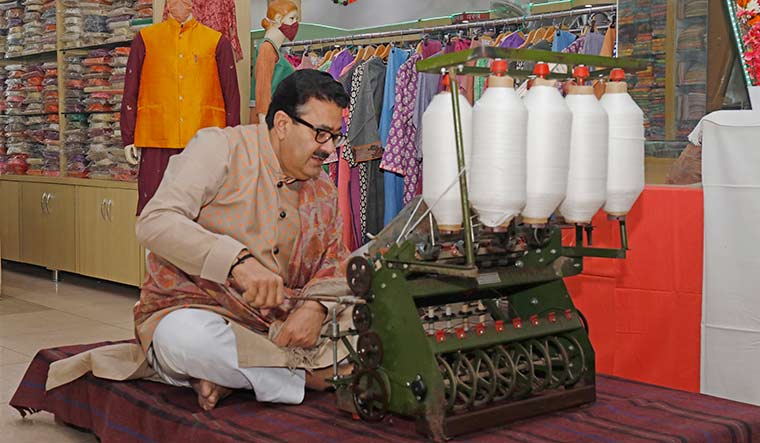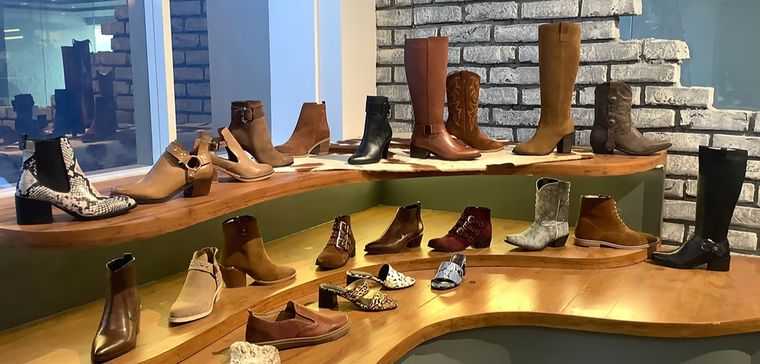IF FABRICS WERE HEROES, khadi would be a superhero.
For how else does one describe a fabric which gets better with age, is skin friendly, adapts to the weather, does no harm to the environment and lasts a really long time?
Now the fabric, long overlooked in favour of its snootier cousin linen, is “going places”, said Navneet Sehgal, additional chief secretary, Uttar Pradesh Khadi and Village Industries Board (UPKVIB).
It is a fabric that gets its name from khad—the Hindi/Punjabi for ‘pit’. It was originally called khaddar—born of the pit loom on which its earliest versions were woven.
Even though the most popular identification of khadi is with Mahatma Gandhi and the freedom struggle (and thus the Gandhi ashrams which retail the fabric and other hand-made products), in his autobiography, Gandhi writes that he had no recollection of when he first saw a charkha. But by 1908 it was clear to him that the surest way to attain freedom was to climb out of poverty by harnessing traditional skills. Weaving was one such skill.
Yet, it took Gandhi’s associates a long time to find charkhas—and when they finally did so in the Bijapur village of the erstwhile Gaekwad state, they discovered that these had been discarded for there was no one to pay for the labour of the weaver. And, thus, was born the push to spin one’s own yarn as a marker of national pride. Self-reliance in clothing by assuring an income to weavers as against mills which spun fabric from foreign-acquired threads was just one of the many strands that went into fuelling the Swadeshi movement against the British. Its guiding light was “atmashakti” or self-reliance, cast now as ‘Atmanirbhar Bharat’.
Thus, there is no time as favourable as now for a return to and reinvention of khadi—for what could be more local than a fabric that is spun across states.
And, Uttar Pradesh has taken the lead in this revival. During the pandemic the state became the first to produce khadi masks through self-help groups. At the last count, the UPKVIB had supplied 3.43 lakh metres of khadi which had been fashioned into some 27 lakh masks by 2,086 SHGs with 20,380 women. Total sales stood at Rs 3.67 crore.
The khadi resurrection in the state began almost as soon as the current government led by Chief Minister Yogi Adityanath—himself an unwavering wearer of handmade fabric—was installed. The first step was the introduction of the Pandit Deendayal Khadi Marketing Assistance Programme which provided, through the year, a rebate of 15 per cent on all khadi production. One third of this rebate is deposited directly in the bank accounts of the spinners and weavers. The rest is to be utilised, in equal parts by khadi institutions for sales and promotion, and management of resources and infrastructure. Till date, 217 institutions and 98,048 artisans have benefitted from the scheme.
The uptick of this scheme is that, unlike the rest of the country which offers a rebate on khadi products only for 100 days from October 2, Uttar Pradesh has a year-round rebate. This has translated into greater sales—from Rs590.16 crore in 2017-2018 to Rs 950.79 crore in 2019-2020 and a steady rise in those employed by the sector from 4.50 lakh to 6.50 lakh.
Sehgal said the scheme also nixed a long-standing problem. “People were bringing khadi clothes from other states for sale in UP to claim the subsidy on sale,” he said. “As a result, most khadi units in the state had stopped production. It was a big racket which the production-based rebate system corrected.”
Khadi, somewhat like religious affairs, has for the most part been a pushover department. But when given charge of it, Sehgal looked for ways to innovate. One of these innovations was to study how production costs of blankets could be brought down in the state’s eight factories which produced these (khadi can be woven into cotton, silk and wool). “By minutely studying the production process we were able to bring down the cost from Rs 800 to Rs 499,” he said. Seven such factories have been revived.
Another out-of-the-box idea was to introduce khadi into the fabric mix used to produce school uniforms. Thus, from 100 per cent polyester, the mix went to 70 per cent cotton and 30 per cent poly-khadi. So far 2,00,752 such uniforms have been provided under the Sarva Shiksha Abhiyan and have generated a revenue of Rs6.02 crore.
Sehgal, himself an ambassador of sorts, often clad in khadi, said, “The possibilities are immense. Just on the school uniform front, for instance, we could produce 10 times more”.
Khadi has moved beyond traditional uses in the state. At Kanpur, a 23-year-old footwear and footwear component company, Arvind Footwear Private Limited, has started to use khadi to line its shoes. Rajendra Kumar Jalan, the CEO of this firm, said that the pandemic had forced him, like the rest of the world, to think of sustainable and eco-friendly products. “I read of a big shoe brand trying to make shoes from plastic bottles picked up from beaches,” he said. “So, I thought, why not make shoes from what was locally handmade.”
In May, the company started sampling materials and is now ready to export cowboy boots to the United States. The upper of the hand-sewn boots is made of power loom fabric, the sole of natural rubber and husk, and they come packaged in recycled paper. Jalan has set himself a unique challenge to ensure that his products are eco-friendly—he has buried a shoe on the factory premises. “In one year, it should all be gone. That is how we will know that it is completely biodegradable and sustainable,” he said, adding that the company’s demand for khadi was met by the government without delay.
Two years ago, the government mounted a glittering fashion show of khadi bridal wear. Rina Dhaka, a designer of international repute, was part of the show. Dhaka said she was “impressed with how the state government was pushing and pushing khadi”.
“Khadi needs to be fashioned and marketed as a product desirable to the youth,” she said. “The information that it is homegrown, handmade and beneficial to the skin needs to be aggressively promoted. We need to look at making hoodies, track pants, boxer shorts and the like.”
Another state government initiative gets weavers to train at the Raebareli campus of the National Institute of Fashion Technology (NIFT). Bharat Sah, the director of the institute, said that though the government did not have a written agreement with the institute, it had set aside an ever-increasing budget for such trainings which take artisans through all stages of fabric construction from surface designing to pattern making. For most weavers such training is their first time ever in an academic setting, and the NIFT’s responsibilities extend to hand holding them after the training and getting constant feedback. So far, 300 artisans have been trained in batches of 30. “We had been showcasing khadi apparel even before this government, but now this has been pushed to a new level,” said Sah. “We have been told to design projects without the fear that we will not get funds for them.”
Manish Tripathi, a Lucknow-born designer aiming to make the world’s largest fabric mask (of area 100 square metres), recently received 150m of khadi from the state government, sourced from all the 75 districts. Thus, what was to be a mask showcasing various fabrics and arts of India, will now essentially be a khadi mask with symbolic representation of other crafts such as Madhubani painting from Mithila.
Tripathi, who is designing a range of corporate wear from khadi, said, “Wearing khadi should make the statement, ‘Hey, I am a responsible citizen’. And the only way to do that is to educate people on what to expect from the fabric—to understand that its creases, folds and imperfections are essential to its beauty.”
However, there remain knotty problems in the state’s push for khadi. For one, the salaries of those who run the Gandhi ashram stores remain low. A manager at one such store in Lucknow said, “I was pushed into working here by my grandfather who was a freedom fighter and had an emotional bond with khadi. I earn less than Rs7,000 a month and am the only employee at this outlet. My daughter is of marriageable age, but I have to think a hundred times before I can pick up my motorcycle and fill it with petrol to go and look up any match for her. Gandhiji lives on through the Gandhi ashrams—through us. Millions are spent on his birth anniversary celebrations. Why not spend some of that money to increase our wages?”
And, for khadi to be a life-saver, such concerns must be addressed.




